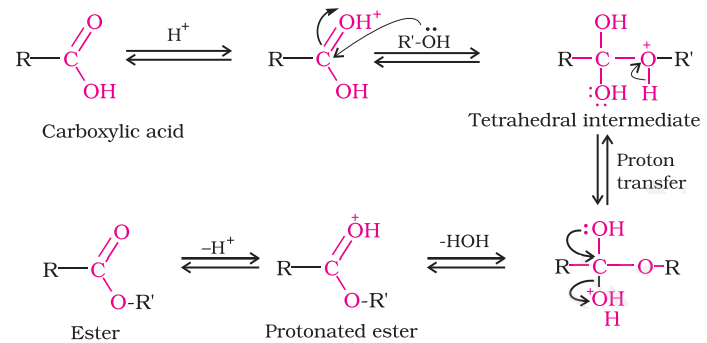
Ethanoic acid reacts with ethanol in the presence of conc.
(A) dehydration
(B) hydrogenation
(C) esterification
(D) disproportionation
Answer
490.8k+ views
Hint: When primary alcohol is treated with a carboxylic acid in the presence of sulphuric acid a compound which has a sweet smell is formed. The compound produced is called an ester.
Complete step by step solution:
The process of combining ethanoic acid with ethanol to form an ester (RCOOR) and water is called esterification. We can also define it as the chemical reaction resulting in the formation of at least one ester product. Concentrated sulphuric acid is used as a catalyst usually. In some cases, dry hydrogen chloride gas is used as a catalyst but these tend to involve aromatic esters.
The esterification reaction is slow and reversible.
Let us see the mechanism involved in esterification.
The oxygen in the carboxyl group gets protonated to give delocalized carbocation making the carbocation a better electrophile. A proton is transferred to one of the hydroxyl groups. It forms a good leaving group. The oxygen atom of the hydroxyl alcohol group donates a pair of electrons to a carbon atom which makes a
So the correct option is (C) esterification.
Note: Esterification can also happen in two other ways. They are from acid anhydride and alcohol; from acid chloride and alcohol. Ester and water are the products in all three processes. Do not confuse it with disproportionation reaction, as in a disproportionation reaction, a compound with intermediate oxidation state converts into two compounds, one with higher oxidation and other with lower. But here, two compounds combine to give an ester.
Complete step by step solution:
The process of combining ethanoic acid with ethanol to form an ester (RCOOR) and water is called esterification. We can also define it as the chemical reaction resulting in the formation of at least one ester product. Concentrated sulphuric acid is used as a catalyst usually. In some cases, dry hydrogen chloride gas is used as a catalyst but these tend to involve aromatic esters.
The esterification reaction is slow and reversible.
Let us see the mechanism involved in esterification.
The oxygen in the carboxyl group gets protonated to give delocalized carbocation making the carbocation a better electrophile. A proton is transferred to one of the hydroxyl groups. It forms a good leaving group. The oxygen atom of the hydroxyl alcohol group donates a pair of electrons to a carbon atom which makes a

So the correct option is (C) esterification.
Note: Esterification can also happen in two other ways. They are from acid anhydride and alcohol; from acid chloride and alcohol. Ester and water are the products in all three processes. Do not confuse it with disproportionation reaction, as in a disproportionation reaction, a compound with intermediate oxidation state converts into two compounds, one with higher oxidation and other with lower. But here, two compounds combine to give an ester.
Recently Updated Pages
Master Class 12 Business Studies: Engaging Questions & Answers for Success

Master Class 12 English: Engaging Questions & Answers for Success

Master Class 12 Social Science: Engaging Questions & Answers for Success

Master Class 12 Chemistry: Engaging Questions & Answers for Success

Class 12 Question and Answer - Your Ultimate Solutions Guide

Master Class 12 Economics: Engaging Questions & Answers for Success

Trending doubts
Give 10 examples of unisexual and bisexual flowers

Draw a labelled sketch of the human eye class 12 physics CBSE

Differentiate between homogeneous and heterogeneous class 12 chemistry CBSE

Differentiate between insitu conservation and exsitu class 12 biology CBSE

What are the major means of transport Explain each class 12 social science CBSE

Franz thinks Will they make them sing in German even class 12 english CBSE




